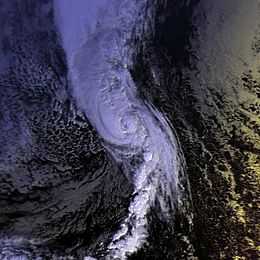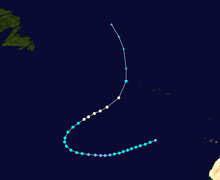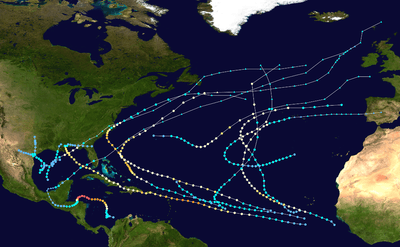Hurricane Nicole (1998)
| Category 1 hurricane (SSHWS/NWS) | |
 Hurricane Nicole near peak intensity | |
| Formed | November 24, 1998 |
|---|---|
| Dissipated | December 2, 1998 |
| (Extratropical after November 30, 1998) | |
| Highest winds |
1-minute sustained: 85 mph (140 km/h) |
| Lowest pressure | 979 mbar (hPa); 28.91 inHg |
| Fatalities | None reported |
| Damage | None |
| Areas affected | No land areas |
| Part of the 1998 Atlantic hurricane season | |
Hurricane Nicole was the last hurricane in the 1998 Atlantic hurricane season. It developed from a frontal low to the south of the Azores on November 24, and quickly strengthened to reach winds of 70 mph (110 km/h) as it moved to the west-southwest. An approaching upper-level trough moved over the system, producing strong wind shear which rapidly weakened Nicole to a tropical depression. After the trough passed, the system entered an area of lighter shear, and steadily restrengthened. An approaching cold front turned it to the northeast, and while moving over anomalously warm sea surface temperatures Nicole attained hurricane status. It reached a peak intensity of 85 mph (135 km/h) on December 1, and rapidly weakened over the waters of the north Atlantic Ocean. Nicole is one of five December Atlantic hurricanes on record.
Origins

A strong frontal low located several hundred miles south of the Azores persisted for several days in late November while remaining nearly stationary. After it began moving steadily to the west, a tightly-wrapped band of convection developed near the center, and it is estimated the system developed into Tropical Depression Fourteen on November 24 while located 725 miles (1,165 km) south of Lajes, Azores. The system quickly intensified as it moved west-southwestward, and strengthened into Tropical Storm Nicole six hours after forming.[1] Tropical Storm Nicole was a small storm, and upon first forming tropical storm force winds extended only 60 miles (95 km) from the center.[2]
A few hours after attaining tropical storm status, a ship just north of the center reported winds of 41 mph (66 km/h), confirming the system was a tropical storm. Located to the south of a strong mid-level ridge, Nicole continued to the west-southwest while centered within a large upper-level low. Common for late-season development in the subtropics, this produced light vertical shear over the storm.[1] The storm moved through an area of marginal sea surface temperatures of 77°F (25°C). An intermittent eye feature of the small area of deep convection, and Nicole quickly strengthened to reach an initial peak intensity of 70 mph (115 km/h).[3] After maintaining its peak for around twelve hours, an upper-level trough moved rapidly eastward over Nicole, which produced high levels of wind shear.[1] The shear weakened the storm, and by late on November 25 the center became exposed to the west of the diminishing deep convection.[4] The shear dissipated most of the convection, and Nicole degenerated to a tropical depression on November 26. Operationally, advisories were discontinued,[1] and regeneration was considered unlikely.[5]
Regeneration

The low turned to the west, and following the passage of the trough a ridge became established over Nicole. This resulted in a decrease in wind shear, and deep convection redeveloped over the storm.[1] The National Hurricane Center reinstated advisories for Nicole on November 27 while located about 1,515 miles (2,440 km) west-southwest of the Canary Islands. The low-level circulation was initially exposed on the southwest side of the convection,[6] though Nicole quickly strengthened and unexpectedly re-attained tropical storm status later on November 27. Upon reaching tropical storm status for the second time, the center of Nicole moved beneath the convection while an anticyclone developed over the storm. Banding features began to develop, and outflow was well-defined.[7] An approaching cold front turned Nicole to the north, and late on November 28 the storm reached its westernmost point while located 1,125 miles (1,800 km) east-northeast of Bermuda.[1]
After turning to the northeast,[1] shear from the approaching front weakened Nicole slightly, and the center became situated near the western edge of the convection.[8][9] Upper-level diffluence allowed the convection to persist despite the shearing environment,[10] and an eye-feature developed within the convection.[11] Anomalously warm sea surface temperatures of 3º to 5°F (2º to 3°C) above normal allowed the storm to continue strengthening, and early on November 30 Nicole strengthened to attain hurricane status while located 1,280 miles (2,060 km) west-southwest of Lajes, Azores. A nearly complete eyewall organized within the storm, and early on December 1 Nicole reached a peak intensity of 85 mph (135 km/h). It turned northward and rapidly weakened, and Nicole became extratropical later on December 1 while located 285 miles (460 km) northwest of the Azores. The extratropical remnant turned to the northwest while moving around the periphery of a larger circulation, and on December 2 Nicole dissipated.[1]
When Nicole lasted into December as a hurricane, it was one of only five Atlantic hurricanes on record in the month. The other five attained the intensity during the month, and included an unnamed hurricane in the 1887 season, Hurricane Alice in 1954, Hurricane Lili in 1984, and Hurricane Epsilon in 2005.[12][13]
Impact
Nicole remained hundreds of miles away from land throughout its entire lifetime, and as a result it caused no damage or deaths.[1]
See also
- Other storms of the same name
References
- ↑ 1.0 1.1 1.2 1.3 1.4 1.5 1.6 1.7 1.8 Lixion A. Avila (1998). "Hurricane Nicole Tropical Cyclone Report". National Hurricane Center. Retrieved October 31, 2006.
- ↑ Lawrence (1998). "Tropical Storm Nicole Public Advisory One". NHC. Retrieved October 31, 2006.
- ↑ Pasch (1998). "Tropical Storm Nicole Discussion Three". NHC. Retrieved October 31, 2006.
- ↑ Pasch (1998). "Tropical Storm Nicole Discussion Seven". NHC. Retrieved October 31, 2006.
- ↑ Pasch (1998). "Tropical Depression Nicole Discussion Nine". Retrieved October 31, 2006.
- ↑ Jarvinen (1998). "Tropical Depression Nicole Discussion Eleven". NHC. Retrieved October 31, 2006.
- ↑ Jarvinen (1998). "Tropical Storm Nicole Discussion Twelve". NHC. Retrieved October 31, 2006.
- ↑ Jarvinen (1998). "Tropical Storm Nicole Discussion Sixteen". NHC. Retrieved October 31, 2006.
- ↑ Mayfield (1998). "Tropical Storm Nicole Discussion Seventeen". NHC. Retrieved October 31, 2006.
- ↑ Pasch (1998). "Tropical Storm Nicole Discussion Eighteen". NHC. Retrieved October 31, 2006.
- ↑ Jarvinen (1998). "Tropical Storm Nicole Discussion Twenty". NHC. Retrieved October 31, 2006.
- ↑ Stacy Stewart (December 2, 2005). "Hurricane Epsilon Discussion Fourteen". National Hurricane Center. Retrieved 2011-0. Check date values in:
|accessdate=(help) - ↑ Hurricane Research Division (2011). "Documentation of Atlantic Tropical Cyclones Changes in HURDAT". National Hurricane Center. Retrieved August 24, 2011.
External links
| Wikimedia Commons has media related to Hurricane Nicole (1998). |
| |||||||||||||
